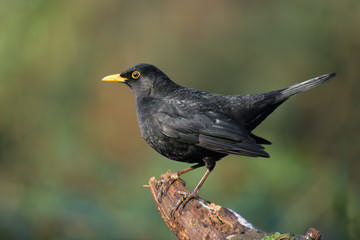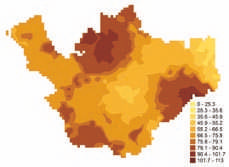
Blackbird © Simon Booth
Blackbird was the equal-second most widespread breeding species and appears to be almost ubiquitous, with little change from our First Atlas across most of the county, apart from odd instances of under-recording. They were, however, more difficult to find, and to prove breeding, in some of the highest eastern tetrads: of the county’s twenty tetrads with a mean altitude above 300 m, Blackbirds were confirmed breeding in seven, probably breeding in three, possibly breeding in eight and not found in two, so they have probably declined somewhat in the hill country. They also used to breed regularly on Hilbre at the time of the last Atlas, but then deserted the island, and the female with an incubation patch trapped in 2006 represented the first suspected breeding for some time.
The figure of 89% of Blackbird records being two-letter codes was exceeded amongst the widespread species only by Blue Tit and Starling, showing how easy it is to prove Blackbirds breeding. Such records came from observers seeing adults carrying food (254 tetrads) or with family parties of their spotty-plumaged recently-fledged young (182), with nests found (NE/ NY/ ON) in 146. Observers have multiple opportunities to record them in their long breeding season, from March to August, with birds nesting up to five times following repeated failures, and some successful pairs having multiple broods as well. In 2006 in Chester (SJ46I), Joe O’Hanlon noted one pair that had four broods, although the last one failed.
The main reason for their near-ubiquity in the county is the Blackbirds’ ability to exploit almost any type of habitat. Their most-used category was human sites (34% of habitat records), followed closely by farmland (33%, nearly all grassland and hedgerows), and woodland (25%). They were more likely to be found in scrub (7%) than the other breeding thrushes. As recently as the mid-19th century, Blackbirds were almost solely confined to their ancestral woodland habitat, and were never found breeding near houses (Parslow 1973). Surveyors included an ‘F’ habitat code amongst the returns from 422 tetrads, almost two-thirds of those with the species, with 43 tetrads recording birds in F1, urban areas. Provided that they can find sufficient food and a suitable nesting site, they can breed almost anywhere, and this is one of the species most likely to make the popular press with stories of unusual locations.
Blackbirds eat, and feed to their chicks, a wide variety of food. Earthworms are a staple, with invertebrates discovered in leaf litter, bare soil or grass, and caterpillars and adult insects found above the ground. Such animal matter is probably the most nutritious, but at any time of year they also take fruits and most things provided by man.

Blackbird abundance.
The BTO BBS analysis shows that the breeding population of Cheshire and Wirral in 2004-05 was 182,810 birds (156,630-209,000), corresponding to an average of almost 140 pairs per tetrad across the entire county. Average figures are not very meaningful, however, as breeding densities can vary enormously, from as high as 1,000 pairs per tetrad in suburbia, through 100 in farmland, to single figures in the difficult upland terrain (BTO Second Atlas). In the best habitats a breeding territory may be as small as 0.1 ha, equivalent to a circle 35 m in diameter.
The Cheshire and Wirral total amounts to 1.8% of the birds in the UK, indicating that the county is relatively important for the species (Newson et al 2008). Their conservation status is reasonably secure. The national population index was in gentle decline, by about 10% during the period of our First Atlas. This accelerated to reach a low point in the mid-1990s, with numbers on farmland especially reduced and the species Amber-listed for a while, but Blackbirds have recovered since, and the present national population is much the same as in 1980.
Sponsored by Mrs Edna Draper

